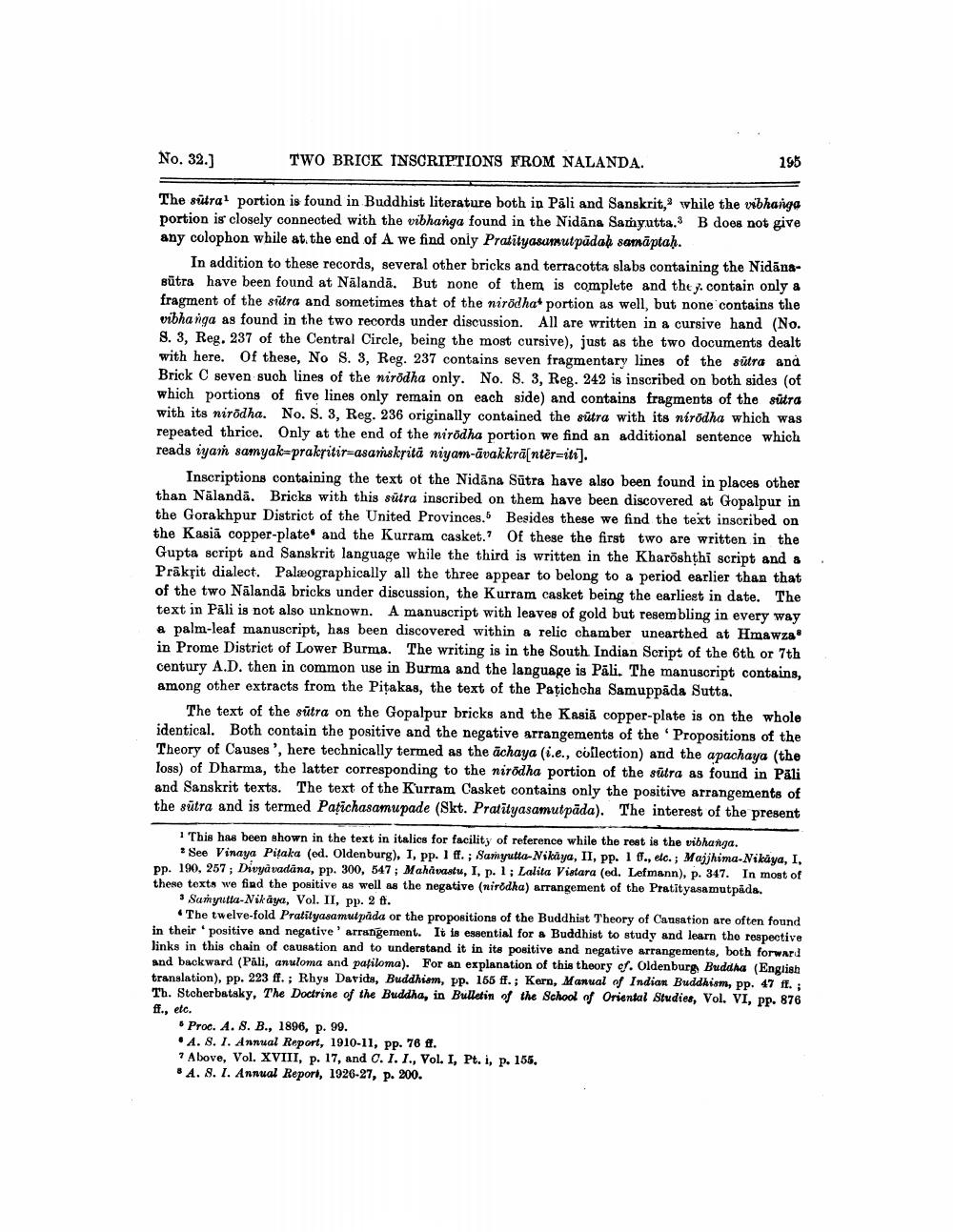________________
No. 32.]
TWO BRICK INSCRIPTIONS FROM NALANDA.
The sutra portion is found in Buddhist literature both in Päli and Sanskrit, while the vibhanga portion is closely connected with the vibhanga found in the Nidana Samyutta.3 B does not give any colophon while at the end of A we find only Pratityasamutpādaḥ samāptaḥ.
195
In addition to these records, several other bricks and terracotta slabs containing the Nidanasutra have been found at Nālandā. But none of them is complete and they. contain only a fragment of the sutra and sometimes that of the nirödhat portion as well, but none contains the vibhanga as found in the two records under discussion. All are written in a cursive hand (No. S. 3, Reg. 237 of the Central Circle, being the most cursive), just as the two documents dealt with here. Of these, No S. 3, Reg. 237 contains seven fragmentary lines of the sutra and Brick C seven such lines of the nirodha only. No. S. 3, Reg. 242 is inscribed on both sides (of which portions of five lines only remain on each side) and contains fragments of the sutra with its nirodha. No. S. 3, Reg. 236 originally contained the sutra with its nírodha which was repeated thrice. Only at the end of the nirodha portion we find an additional sentence which reads iyak samyak-prakritir-asatiakriti niyam-āvakkrā[ntër-iti],
Inscriptions containing the text of the Nidana Sutra have also been found in places other than Nālandā. Bricks with this sutra inscribed on them have been discovered at Gopalpur in the Gorakhpur District of the United Provinces. Besides these we find the text inscribed on the Kasia copper-plate and the Kurram casket. Of these the first two are written in the Gupta script and Sanskrit language while the third is written in the Kharoshthi script and a Prakrit dialect. Palæographically all the three appear to belong to a period earlier than that of the two Nālandā bricks under discussion, the Kurram casket being the earliest in date. The text in Pali is not also unknown. A manuscript with leaves of gold but resembling in every way a palm-leaf manuscript, has been discovered within a relic chamber unearthed at Hmawza in Prome District of Lower Burma. The writing is in the South Indian Script of the 6th or 7th century A.D. then in common use in Burma and the language is Pali. The manuscript contains, among other extracts from the Pitakas, the text of the Patichcha Samuppada Sutta.
The text of the sutra on the Gopalpur bricks and the Kasia copper-plate is on the whole identical. Both contain the positive and the negative arrangements of the Propositions of the Theory of Causes', here technically termed as the achaya (i.e., collection) and the apachaya (the loss) of Dharma, the latter corresponding to the nirodha portion of the sutra as found in Päli and Sanskrit texts. The text of the Kurram Casket contains only the positive arrangements of the sutra and is termed Patichasamupade (Skt. Pratityasamutpada). The interest of the present
1 This has been shown in the text in italics for facility of reference while the rest is the vibhanga.
See Vinaya Pitaka (ed. Oldenburg), I, pp. 1 ff.; Samyutta-Nikaya, II, pp. 1 ff., etc.; Majjhima-Nikaya, I. pp. 190, 257; Divyavadana, pp. 300, 547; Mahavastu, I, p. 1; Lalita Vistara (ed. Lefmann), p. 347. In most of these texts we find the positive as well as the negative (nirodha) arrangement of the Pratityasamutpada.
3 Samyutta-Nikaya, Vol. II, pp. 2 f.
The twelve-fold Pratityasamutpada or the propositions of the Buddhist Theory of Causation are often found in their positive and negative' arrangement. It is essential for a Buddhist to study and learn the respective links in this chain of causation and to understand it in its positive and negative arrangements, both forward and backward (Päli, anuloma and patiloma). For an explanation of this theory ef. Oldenburg, Buddha (English translation), pp. 223 ff.; Rhys Davids, Buddhism, pp. 155 ff.; Kern, Manual of Indian Buddhism, pp. 47 ff.; Th. Stcherbatsky, The Doctrine of the Buddha, in Bulletin of the School of Oriental Studies, Vol. VI, pp. 876 ff., etc.
Proc. A. 8. B., 1896, p. 99.
A. 8. I. Annual Report, 1910-11, pp. 76 ff.
7 Above, Vol. XVIII, p. 17, and C. I. I., Vol. I, Pt. i, p. 155.
A. 8. I. Annual Report, 1926-27, p. 200.




